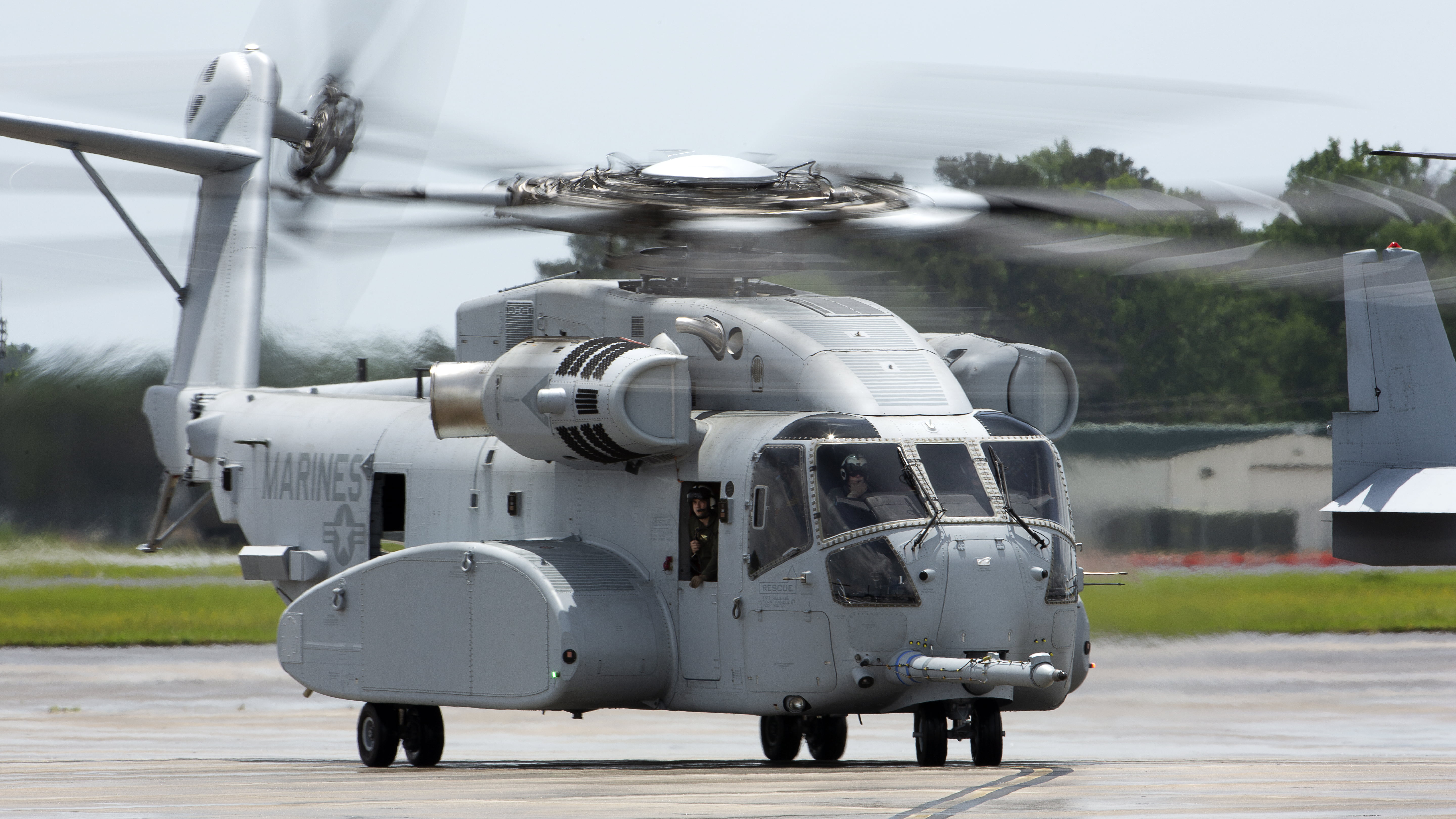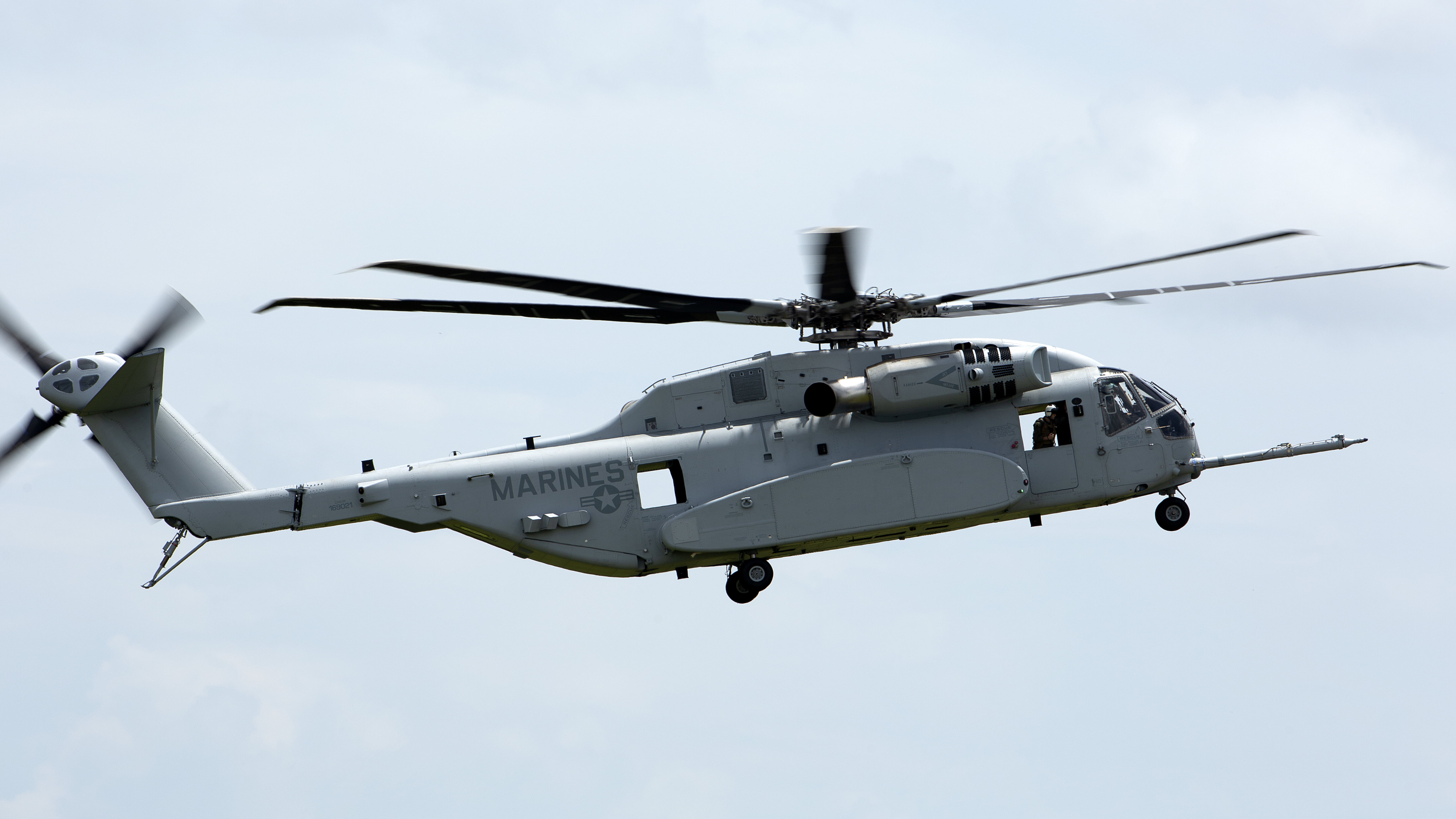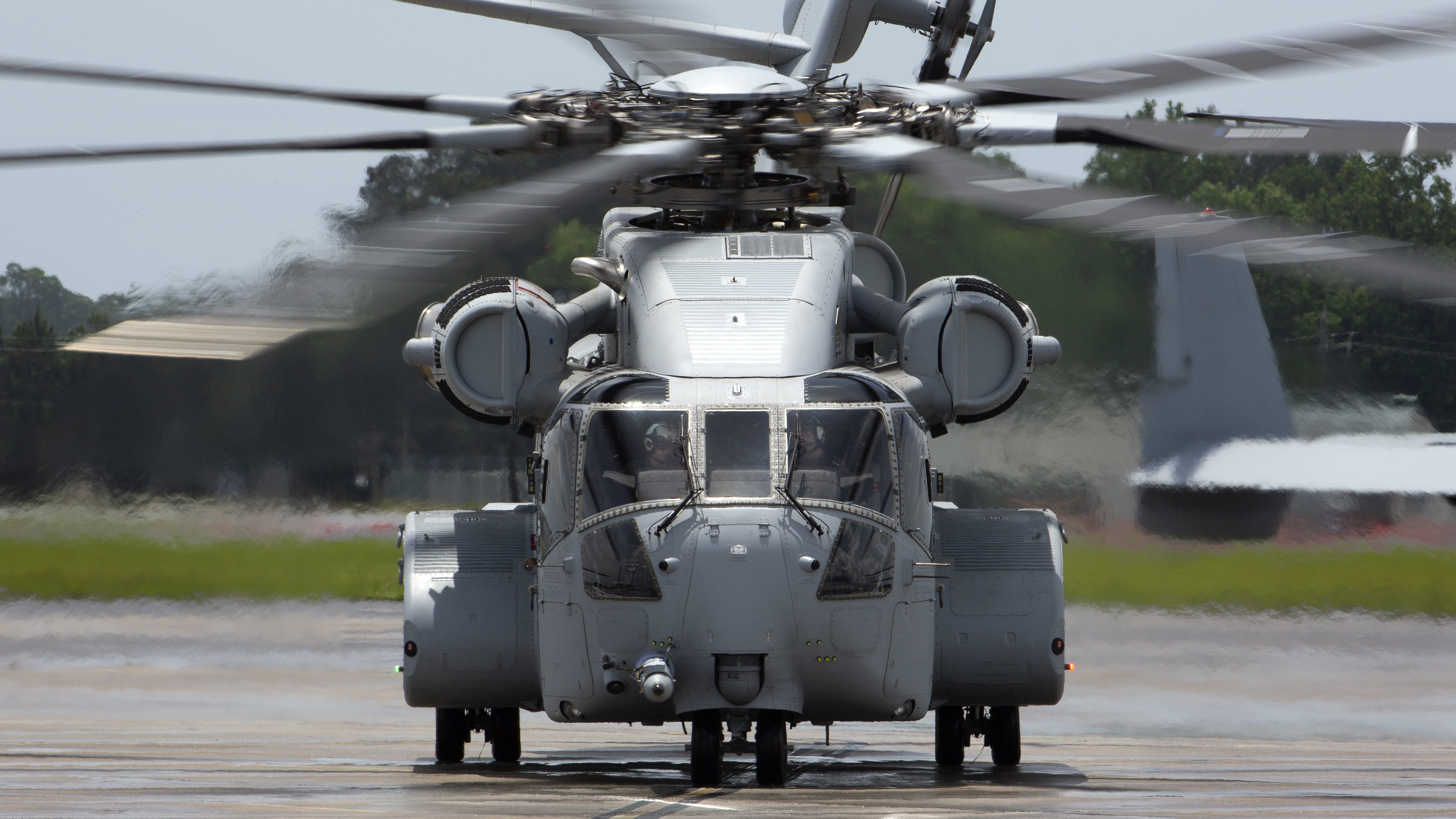A key element of building 21st century air systems is building in sustainability as part of the design.
21st century air systems are digital systems, built around software upgradeability.
The digital capabilities of the aircraft are a key part of building out a more sustainable combat system.
The CH-53K was designed with several USMC maintainers as part of the design process.
Now the Marines have taken delivery of their first CH-53K at New River where the first squadron will be based.
The focus of the work to be conducted is precisely to work on the maintainability of the aircraft.
A CH-53K arrived on May 16, 2018 at New River for a sustainability test regime.
This will be performed by the former VMX-22 which was formerly based at New River and brought the Osprey into the Corps and supported its development for more than a decade.
Currently, Marine Operational Test and Evaluation Squadron 1 is based at MCAS Yuma and is working closely with the F-35B and its integration within the USMC and shaping its impact on USMC transformation as well.
Now the CH-53K will joint the process of air-enabled transformation generated by Marine Corps Air for the MAGTF.
We interviewed members of the squadron while in Yuma recently and will report on those discussions later this month.
“The helicopter’s arrival to New River enters it into the Supportability Test Plan where U.S. Marines will conduct a logistical assessment on the maintenance, sustainment and overall aviation logistics support of the King Stallion,” the Corps said in a command release Wednesday.
“I am very proud of the work accomplished to deliver the most powerful helicopter ever designed into the hands of our Marines,” Lt. Gen. Steven Rudder, deputy commandant for aviation, said in a command release.
The Corps plans to field a total of 200 CH-53Ks over the coming years. The first eight of that “program of record” currently is under contract.
According to a story published May 16, 2018 by Ben Werner in USNI News:
The Marine Corps accepted delivery of the first Sikorsky CH-53K King Stallion Wednesday, marking an important milestone on the path to achieving initial operational capability sometime next year…..
The CH-53K King Stallion program officially titled the CH-53K Heavy Lift Replacement Helicopter program – is a new production aircraft destined to replace the existing CH-53E Super Stallion fleet currently used by the Marine Corps.
The CH-53E first flew in 1974 and entered Marine Corps service in 1981.
The Department of Defense plans to purchase 200 CH-53K aircraft. The first eight are under contract and Sikorsky will continue delivering them to the Marine Corps through the year. The Marine Corps plans to ultimately field eight active-duty King Stallion squadrons and one reserve squadron…..
Meanwhile, Sikorsky is also starting to promote the CH-53K and its capabilities to potential international customers. Sikorsky demonstrated the King Stallion’s capabilities at the recent ILA Berlin Airshow in Berlin, Germany.
One of the CH-53K enhancements over previous helicopters is what Sikorsky officials have described as an integrated health management system, which monitors parts on the aircraft.
This system allows military technicians and Sikorsky officials better plan for when servicing is needed, and ultimately help control costs, according to Sikorsky officials.
In 2016, we interviewed senior Marines involved with the program about how central maintainability was to the design and development process:
A key argument for buying newer platforms compared to older ones is the savings built into a new platform over the operational and logistics costs of the older platform.
In the commercial airplane business, both Boeing and Airbus design and build their newest platforms with significant enhancements in sustainability in mind.
According to one senior official at Airbus, “We have a design committee which reviews recommendations with regard to sustainment and logistics support from commercial customers to determine the most desirable enhancements we might then build into the new aircraft (the A350).
We then determine priorities and feasibility’s with regard to the design approach and manufacturing process to shape the new build aircraft.”
This is true as well for military aircraft as well and can be seen in platforms such as the F-35, the A400M, the KC-30A and in other 21st century air platforms as well.
And the CH-53K is being shaped in the midst of this maintainability focus on design and manufacturing.
In an interview with three key Marines involved in the program we started by focusing upon the maintainability and sustainability aspects of the new air system.
The three Marines were as follows: Col. Paul Fortunato, Branch Head, Weapons Requirements (APW-1); Col. Hank Vanderborght, Program Manager, PMA-261/H-53 Heavy Lift Helicopters; and Major Thomas Trimble, Heavy Lift Requirements (APW-51), Department of Aviation, USMC.
Question: How important has it been building in maintainability to the CH-53K design approach?
Answer: It has been central from the beginning.
We formed a maintainer working group at the outset as part of the design team which has met every quarter to provide their recommendations from a maintainer’s perspective with regard to ways to improve the design from a maintainability and sustainability perspective.
Question: These were veteran CH-53E maintainers providing operational experience to guide CH-53K design?
Answer: That is correct.
Even though the aircraft is quite different, we wanted that field experience built into the design process from a maintainer’s perspective.
For example, on the CH-53E when you have to work on or replace the fuel cell you have to do so through big trap doors on the top of the aircraft. And then one has to wait a couple of days to have the gas free environment on which to work on the cell.
A maintainer suggested that we build a port on the bottom of the K where one can access the fuel pumps directly and easily, and then if you have to change the fuel pump inside the tank, you could go underneath the aircraft, unscrew it, pop in a new one, connect it and off you go.
You don’t have to wait until a gas free engineering environment is ready.
There are several examples of this kind of input to the design of the new aircraft, which will enhance maintainability, which, in turn, enhances readiness and sortie generation.
And the design of the avionics systems is built around an avionics box for easy access to the cannon plug and wires, which the maintainers need to work on. Instead of having to have a flashlight, a mirror and another Marine holding something to get behind the systems, the systems are facing the maintainer directly for their attention.
Question: This means that you are shaping a maintenance culture change as well as those maintainers work inputs to the design and start to focus on how their job will change as well?
Answer: That is a good way to put it.
The team working the new maintenance approach are the future stakeholders.
You are generating buy in as their ideas are incorporated into the design.
Currently, we have 10 maintainers at West Palm working on the aircraft.
These are the seed corn for the new maintenance approach working with the new aircraft.
Their recent fleet experience has prepared them to act as a critical link between engineers and end users in the development the helicopter and the knowledge they gain during their time on the program.
We are counting on these Marines to reenlist and be our Staff Non-Commissioned Officers assuming leadership roles as future Quality Assurance Representatives and Division Chiefs of the first King Stallion squadrons.
Question: You are now in the test process, so where do the maintainers fit into that process?
Answer: The NAVAIR process is somewhat like a V where one side is design and the other is testing and fielding.
We are now largely past the design piece and we are now focused on test and aircraft performance under those test conditions.
The ten maintainers that are down at West Palm are actually maintaining the aircraft.
They are validating maintenance procedures while identifying best practices, while noting and correcting any discovered deficiencies.
Question: And the maintainers we are talking about for the K are part of this new generation of electronics or digital maintainers.
How do you see that fit?
Answer: That is a good point.
The airplane is much more digital; and so are the maintainers; there is an evolving fit between the 21st century aircraft and the 21st century maintainer.
They are shaping the integrated manuals we need to support the aircraft in the field. They going to make sure that the manuals are written correctly.
That is why it so crucial to have the maintainers down at West Palm and integrated into the process from the outset.
Question: We have been discussing digital systems.
How has the Sikorsky approach to a Heath and Usage Monitoring System (HUMS) on its commercial helicopters affected the K program?
Answer: It is a crucial part of the program.
For example, Sikorsky has more than 10 years of experience with the HUMS on the S-92, a helo that is flown three times as much as we would fly the K.
43 Sikorsky CBM-HUM Past Present Future_2-9-15_Cycon
It is used for fleet management, and provides significant information with regard to the operational performance of the aircraft, parts and reliability and overall real-time data with regard to the operation of the aircraft.
We are leveraging this approach for the K and clearly when the E was built there was no HUMS system or capability.
An example from the S-92 world provides some insight into where we think the K fleet can go as well using the HUMS system. They’re measuring every aircraft across the fleet and they understand the signatures for every parameter they’re measuring looks like.
So they understand what normal looks like and if something starts deviating from normal they can understand where the safety margins are.
One example that sticks in my mind was an S-92 that was flying for an oil company in the Singapore area doing globe plots. And they had a tail rotor gearbox in this aircraft that was showing some signs of wear and tear.
And they knew that the operator was going to need to have in about 20 flight hours dedicated base maintenance.
So before the operator even knew that there was something going awry with the aircraft, they called the operator and said, this scheduled maintenance period you need to change your tail rotor gearbox. By the way we shipped you a brand new one yesterday.
We certainly look forward to such a capability within the K fleet.
In short, the predicate for the K is 21st century aircraft materials, systems and approaches.
The E was built in the age of the Studebaker; the K is built in the age of the electronically-enabled car.
In and of itself, that makes it a very different animal.
This article was first published on March 6, 2016.
For our articles on the CH-53K, including ones addressing maintainability and supportability, see the following:
https://defense.info/system-type/rotor-and-tiltrotor-systems/ch-53k/





